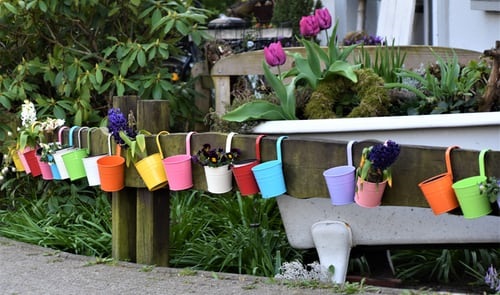Choosing a garden planter sounds easier said than done. All you need to do is make a preferential choice between the countless colors, shapes, materials, and styles, and then you can just grab one and go, right? Well, no. There are endless pretty plant pots on the market. However, we should not make our decision just on the basis of our personal preferences. There are several factors that you need to consider to ensure that your plants grow healthy, which can be difficult, especially if you’re not an expert in the field. Fortunately, we’re here to tell you how you can choose the perfect garden planter that is best suited for your needs.
Plant Assortment
When you’re choosing garden planters, you should never overlook your plant selection. While you don’t need to know exactly which types of plants you will be growing in your garden, it helps to make informed decisions. Look into the plant options that interest you and find out whether they can survive in dry environments. You should also know their mature size in order to select a pot large enough to support the root balls of the plants. Think about whether you’ll be adding ornamental grass in the planter if you plan to combine plants in one pot, and if you will be using them as decorations for your home or office.
Watering Requirements
If you won’t be able to water your plants every day, you may need to buy a planter with a reservoir or drip tray. You can fill it up from the bottom, which allows your plant to soak up water whenever it needs to. Plants that are deprived of water may perish. As the pressure inside the stems and leaves drops, they wilt. Plants, too, require water for photosynthesis.
Material
Garden planters come in numerous materials. The most common ones include wood, metal, stone, concrete, terra cotta, fiberglass, resin, and plastic. Knowing the difference between each can help you choose the best garden planter for your needs. Wood containers are great at withholding and retaining water. If you plan on purchasing a wooden container, go for hardwood ones as they hold up well against rot. However, you can still treat whichever wooden pot you buy with preservatives. Keep in mind that wood expands and shrinks as moisture levels fluctuate, so search for good quality joints and construction. Metal containers are great for tall plants since they’re heavy. The problem is that they can heat up quickly, which requires frequent watering. Otherwise, the roots of your plants would bake.
Stone and concrete pots can maintain moisture and temperature levels. They effectively insulate heat but aren’t ideal if you plan on moving them later. They’re good choices if you need a planter that your pets won’t be able to knock over. Terra cotta is one of the more traditional garden planter materials. However, they dry out quickly and are quite porous. Most of them aren’t resistant to frost either.
Although they’re cheaper, synthetic pots are now almost identical to natural materials. Resin and fiberglass are affordable, durable, and light, which is perfect if you’d like to move your pots around. They are also usually resistant to frost. Plastic pots are great at conserving moisture. They’re also very light and semi-flexible, making them ideal as liners and perfect for cold winters. You can even use plastic as the main garden planter and slip it into a nice, decorative pot of your choice. This way, you get the best of both worlds.
Exposure and Weather
You need to consider the weather and conditions where you live. Is it mostly sunny or breezy? Are there strong winds? As we explained, some garden planter materials can’t be knocked down easily, may dry out faster, be good at retaining moisture, etc. If you will be growing your plants where there is heavy sun exposure, you wouldn’t want to use a porous garden planter for your plants. If you’ll be leaving your plants out during the harsh winter climate, you’ll have to use a material that is resistant to frost.
Mobility
Think about whether you may need to move your pot around frequently. For instance, if you’re placing your planter on a deck, plan to move your plant around to accommodate the sun or shade, or move it indoors during the wintertime, you need to ensure that the material of the container allows you to do so. Heavy containers, like metal garden planters or large ones in general, aren’t great in terms of mobility.
There are endless garden planters that we can use on porches, decks, gardens, and inside our homes. Choosing the right ones for your needs is not an easy task, especially when you lack the needed knowledge of botany. Fortunately, this simple guide will help you choose the perfect garden planter for you and your plants.

